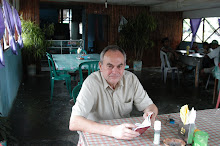



Just crossed the Tropic of Capricorn yesterday on our way south - it's getting cooler already - a maximum of ONLY 33 degrees forecast today. Carnarvon's a lovely place, but problems with the public library's internet system, but now finally here's the last few days' update:
Ned’s Camp, Cape Range National Park, Saturday 7.11, 21 59 S, 113 56 E, 1982 km
Talk about “on the beach” – here we’re in one of 12 camping grounds with a total of 102 spots on a 60 km stretch of National Park, no other camping allowed, no water or electricity, just wild nature and the 300 km long Ningaloo reef just a few strokes offshore, then the Indian Ocean and about 7000 km westwards the first land is Madagascar. A little too much wildlife for Ros in the outdoor loo though – a tarantula looking spider over the door, as big as your hand! Termite mounds she can handle, but not these spiders!
A pleasant sea breeze and tamarisk shade makes a pleasant contrast to the intense desert heat – in fact we were quite “cold” last night – it was only 22 degrees and we had to use a down for the first time. It will be quite a shock getting back to Norway in 10 days time......
A great “happy hour” at sundown last night as people from all 12 spots here gathered for a beer at sundown – an ozzie camping tradition it seems – talking to pensioners who’ve been travelling Australia for 13 years and to “first-timers” who’ve taken a year off work to see their own country... Like other people we’ve talked to, they move from place to place, taking the odd job here and there for a few weeks at a time, generally enjoying life, the nature and the climate – makes us quite envious! So a fantastic night by the ocean, with a kangaroo for company as the sun comes up over the inland dunes behind us....... Today snorkelling and sunning planned, a lazy beach day.
Ningaloo Lighthouse, Sunday evening 8.11
Plans changed a little yesterday – Ros woke with a stomach bug and i got burned to a frazzle snorkelling in the lagoon behind the reef at beautiful Turquoise Bay – very careless, forgetting that I’ve been driving for so much that I haven’t had much time to enjoy the Australian sun! So we decided to hunker down and rest in a pleasant camping ground on Vlamingh Point just north of the National Park boundary, in a basic but (as usual here) very comfortable little cabin, campervan plugged in and recharging outside.
Strange to think that this entire area was barren sheep station country with nothing but a lighthouse until the early 1960s – a temporary air base during WW2, but otherwise nothing. It was only in the 60s that Ozz and the US established a large secret communications base – extreme low frequency to communicate with all the subs in the Indian and Pacific oceans – that Exmouth developed as a town, originally to serve the base, and gradually to cater for tourists – with building now started of an horrific marina complex which will transform this dozy nondescript but pleasant village into a high-rise nightmare....
Today didn’t do much at all, a short trip back into the park for a quick dip, but low enthusiasm because of all the bush flies – and agreed that the lagoon snorkelling wasn’t all that exciting compared to Timor or Queensland’s Barrier Reef. Watched sunset from the lighthouse high on a (Miocene) limestone bluff and then the news on TV for the first time for weeks, followed by a very good programme on Charles Darwin..... Onwards tomorrow, all being well.
Carnarvon, Monday 9.11, 24 53 S, 113 40 E, 2612 kmSo now we’re officially out of the tropics! We passed the Tropic of Capricorn about 150 km north of here and duly took piccies of each other in front of the sign by the road. Carnarvon is a major centre in the area, all of 7,000 population, along the Gascoyne River estuary, with fruit and vegetable farming (looks like mainly bananas) and fishing as its main pursuits, as well as servicing all of the cattle and sheep stations in the area (Carnarvon “School of the Air” provides radio schooling for all the stations within an enormous area – including Giralia Station, where we stayed on Thursday). Looks a pleasant place as we arrive just an hour before sundown, and the temperature certainly more moderate than we’ve had for a while – forecast max tomorrow only 33 degrees, quite cool!
In Exmouth we met yet again the Japanese cyclist who we’ve passed several times recently and stopped to talk to him for the first time. He spoke very poor English and had a bad speech impediment, but I understood that he’s cycled the same route from Cairns that I’ve driven – that’s 7,000 km in 11 months – an average of over 200 km a day! And in this climate......
We drove on amazed, then stopped at Coral Bay, near the southernmost point of the Ningaloo Reef, and had a great 2-hour trip in a glass-bottomed boat over the reef, with two snorkelling stops – lots of fish and corals, but again not much colour, not so exciting as the Great Barrier – the Queenslanders we’ve talked to are right!



















